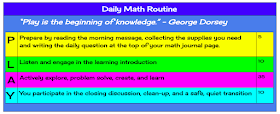Teach ALL Children Well
 As a fifth grade teacher, my main goal is to teach each and every one of my students as well as I can. That's why I'm reading Culturally Responsive Teaching and The Brain this summer. It's a book that will help me to elevate the ways I teach all students.
As a fifth grade teacher, my main goal is to teach each and every one of my students as well as I can. That's why I'm reading Culturally Responsive Teaching and The Brain this summer. It's a book that will help me to elevate the ways I teach all students.Teach Math Well
 The world of math education is exploding in wonderful ways right now, and I'll try to keep up by reading Routines for Reasoning, updating my math-related Google docs and website, creating two-three deep math learning performance tasks for the 2019-2020 school year, learning to use Graspable Math, advocating for an updated math RTI approach, and re-organizing math supplies and the classroom in general to support optimal math teaching.
The world of math education is exploding in wonderful ways right now, and I'll try to keep up by reading Routines for Reasoning, updating my math-related Google docs and website, creating two-three deep math learning performance tasks for the 2019-2020 school year, learning to use Graspable Math, advocating for an updated math RTI approach, and re-organizing math supplies and the classroom in general to support optimal math teaching.Teach STEAM/Science Well
I'll work with my grade-level colleagues and naturalists/educators from Massachusetts Audubon's Drumlin Farm to update our standards-based environmental education efforts with a second-year focus on the SUASCO Watershed and Climate Change. We had a successful year one with this project, and now we'll work to better what we did in year two. To support this study, I'll also attend a Wade Institute multi-day summer science study which will give me a lot of information to inform this work.
Family First
Of course summer is a great time to focus on family relationships and good times. That focus means working to better organize/update our home and yard, preparing for and participating in family get togethers, and being there to support family members with various needs.
Health and Fitness
I tend to put this on a back burner, but I signed up for a sports event that will hopefully inspire greater attention to this focus.
Local Union
I have some work to do to update our union website and organize multiple emails and other information so we can keep good track of the efforts we're involved in.
Political Action
As one who believes we can do a better job in the USA to uplift all lives, there's lots of work to do. I know that my work as a teacher and union member contributes to this. I also support political candidates who mirror my beliefs about what we can do to make our country a stronger, better country for all. There is so much room for good involvement here, and I will continue to think about how I might best match my skills, knowledge, and abilities with this potential.
Blogger, Tweeter, Writer for Betterment
I love to think, research, read, and write. I like to share my questions, knowledge, ideas, and creations with others. I share in hopes that what I have to say may be what others are looking to read, wonder about, or respond to. I read ideas from all kinds of people in all kinds of places--their thoughts, research, and work inspire me in countless ways. I hope that my work will serve to inspire some. In many ways, I have felt that less share of good ideas has resulted in less opportunity. It seems that some like to keep good ideas, information, and opportunities a secret with the notion that sharing will dilute their opportunities. On the other hand, I believe the more we all know and share, the better we can all do. I write with the belief that there's enough to go around, and with good synergy, we can uplift lives all over the globe. In my long life, I've seen the results of good ideas, collaboration, and advocacy in better lives, more opportunity, and good living. I want to see that scale so that few to no people on Earth live with unnecessary suffering, inequity, pain, or struggle. While I understand that no life will be perfect, I also know that there is such a think as unnecessary struggle. For example, it's foolish for us to sit back and allow innocents to be injured or killed by gun violence when we know that new regulations, restrictions, and reduction will lesson such anguish and pain. Similarly we know that the Earth can produce enough healthy food to feed everyone, yet we don't work hard enough to eliminate starvation. There's so many ways we can better live for all, and that's why I research, read, write, advocate, and work for betterment at home, at work, and elsewhere.
What am I missing?
These are my priorities right now. If you have anything to add, let me know. Prioritization in this busy, ever changing world of limitless opportunity for positive effort and impact is essential so that we arrive at the places we seek. Onward.





















